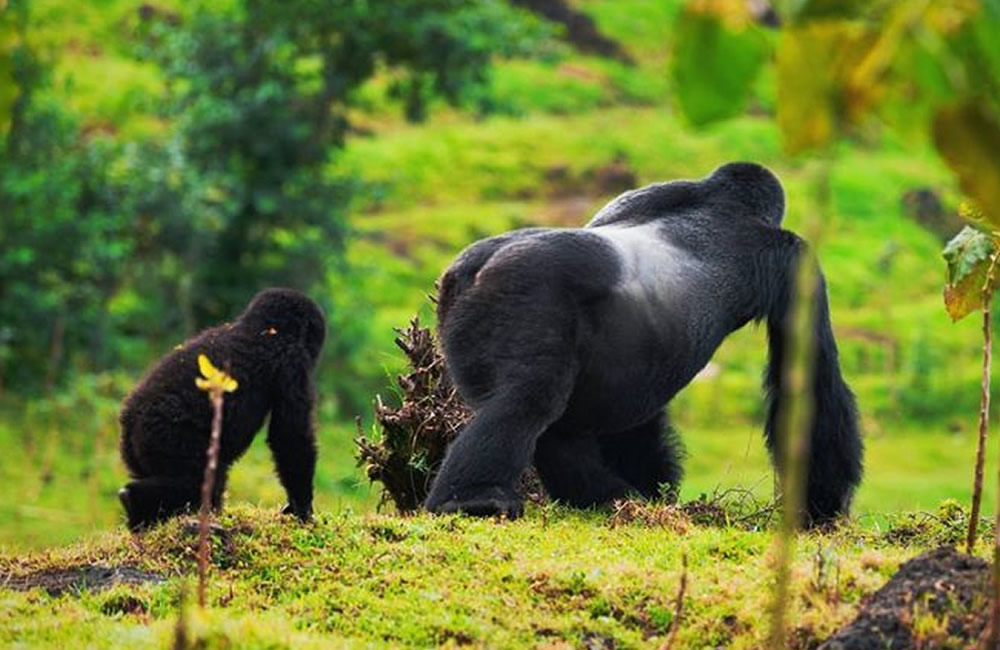Countries where mountain gorillas live i.e Uganda, Rwanda and Democratic Republic of Congo can come together in partnership with local people and international conservation organizations to put up strong conservation policies and measures that can help to protect and conserve gorillas.
This can help in creating solutions to reduce threats and conserve gorillas through strategies including; Protection of gorilla habitats through effective trans-boundary management, supporting local communities living near gorilla national parks through development projects and alternative resources and Putting to an end poaching and illegal trade of gorillas or their products.
The protection of gorilla habitats can became effective since gorilla national parks were gazetted and transformed into ecotourism destinations and have the ranger based monitoring systems implemented to keep on monitoring gorillas by the park rangers and guides. In the process of conserving mountain gorillas, the other subspecies of eastern and western gorillas in DRC can also receive conservation attention including other wildlife that share habitats with mountain gorillas can help diversity of wildlife relevant besides gorillas.
In order to reduce the risk of disease transmission and to avoid disturbing the gorillas’ natural behavior, the Gorilla Doctors can work with national park authorities to establish the rule of staying 7 meters (21 feet) or more from the gorillas at all times during gorilla treks in natural habitats. The gorillas themselves, especially young ones don’t know the rules and may approach humans, but tourists should make sure they stay away and avoid touching the animal if possible. The 7-meter rule should be observed at all times, even when gorillas leave the national park and venture on to property owned by tourist lodges and camps in order to reduce diseases.
Due to the genetic similarity between humans and mountain gorillas, gorillas are susceptible to many of the same infectious diseases that affect people. Mountain gorillas are also immunologically naïve to some diseases, meaning they are particularly susceptible to certain human diseases because of their historic isolation from people.
Research conducted by the Gorilla Doctors and other scientists has proven that mountain gorillas have died as a result of infections that originated in people. Infectious disease, after trauma, is the leading cause of death in mountain gorillas. The most common infection is respiratory disease, which can range from mild colds to severe pneumonia. To protect gorillas from such infections, the national park authorities can ask that anyone feeling sick or running a fever must not go for gorilla safaris in the jungles of Bwindi and Virunga.
One of the most effective ways to help mountain gorillas is to donate money to organizations working on the ground to conserve the species. Numerous organizations including MGVP have spent decades finding effective methods for protecting mountain gorillas, and most rely on grants and donations to fund their work. When donating your money to support any cause, it’s important to evaluate the organization you’re considering supporting to determine how successful the group is in carrying out its mission. You should get to know what methods do such organizations use to accomplish their stated goals. This is when you can’t afford to make significant personal donation or travel to Africa.
Anyone can make a difference for the gorillas by telling their friends, family, and colleagues about the mountain gorillas and the efforts being made to save them. Remember that even though mountain gorillas are critically endangered, their story is a positive one! Mountain gorillas are the only subspecies of non-human great ape growing in number. This species has a fighting chance for survival if you continue to work to address conservation challenges. This can be done by telling everyone the importance of conservation and protecting the endangered species.
Explore the area with other activities as well.
Don’t rush to come and track the gorillas and then leave at once. Take your time and spend one or two days extra to discover the beauty of the surroundings. The revenue earned is further incentive for the government and local communities to protect the habitat of the mountain gorillas.
Don’t buy products made with wild animal parts.
Gorillas often get caught in poachers’ snares set for other animals in the forest. Furthermore, poachers’ very presence in the forest disturbs the environment and increases the risk of zoonotic disease transmission. While the main purpose of poaching is to obtain bush meat, wild animal skins, bones, and ivory may be used in crafts and other items sold to tourists. If you have any doubt about a product’s origins, don’t buy it. And certainly, in the rare instance you may see or hear of someone selling a live wild animal, report it to the national park authorities.
Increasing support for gorilla conservation among both local and international communities. Gorilla conservation programs not only work to protect the gorillas themselves but also help to protect thousands of other species of animals and plants that are found in gorilla habitat.
In conclusion, gorilla conservation requires both local and international support; awareness building, strong law enforcement and conservation policies that not only protect gorillas but also motivate people including tourists to understand hoe gorillas should be protected and conserved. Educative programs about the health of gorillas as well as health of people and environmental awareness are such endless important issues that keep highlighting the need for continued conservation efforts to save mountain gorillas.
This article was reproduced from from the Gorillaland.

Leave a Reply